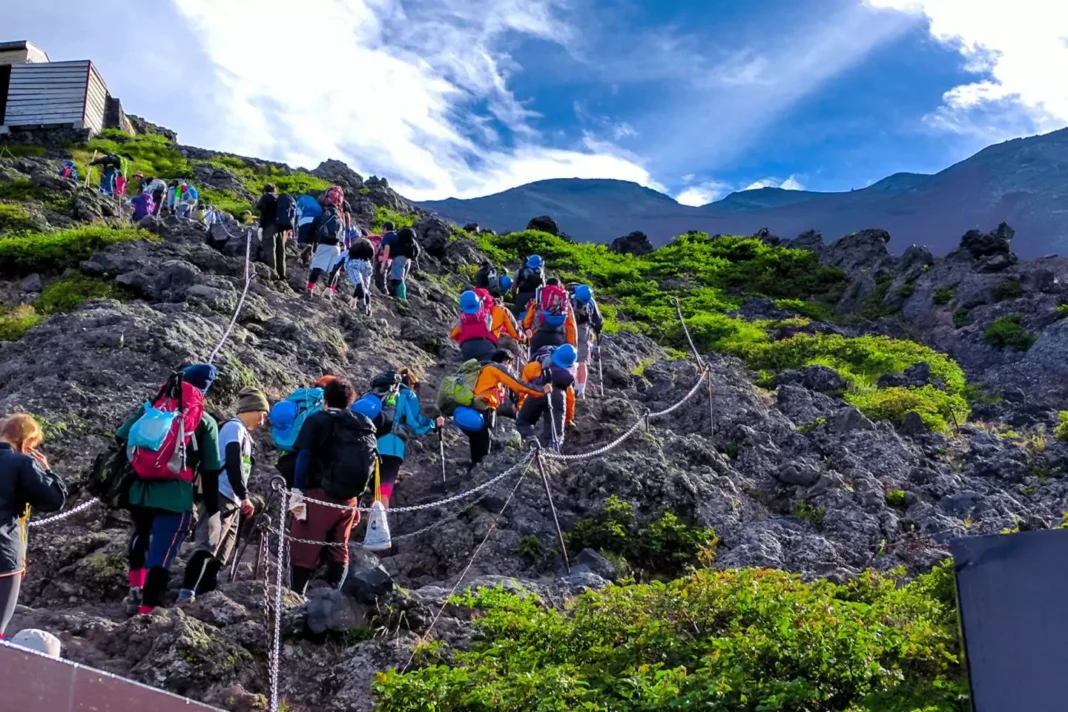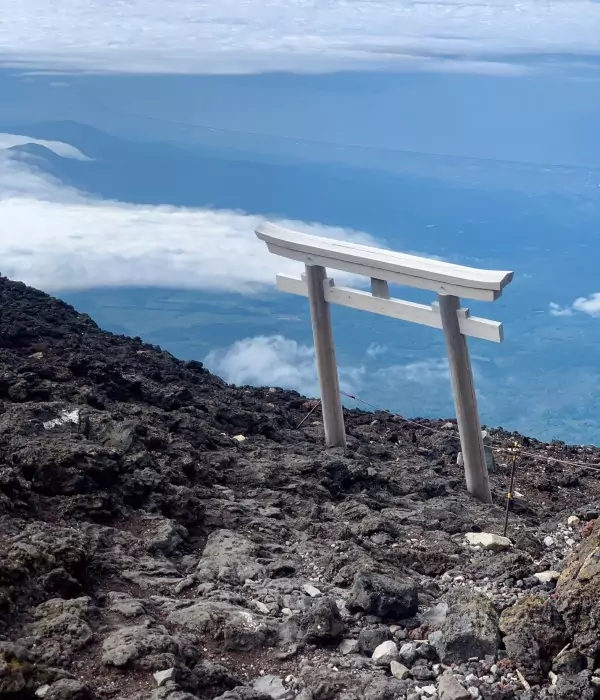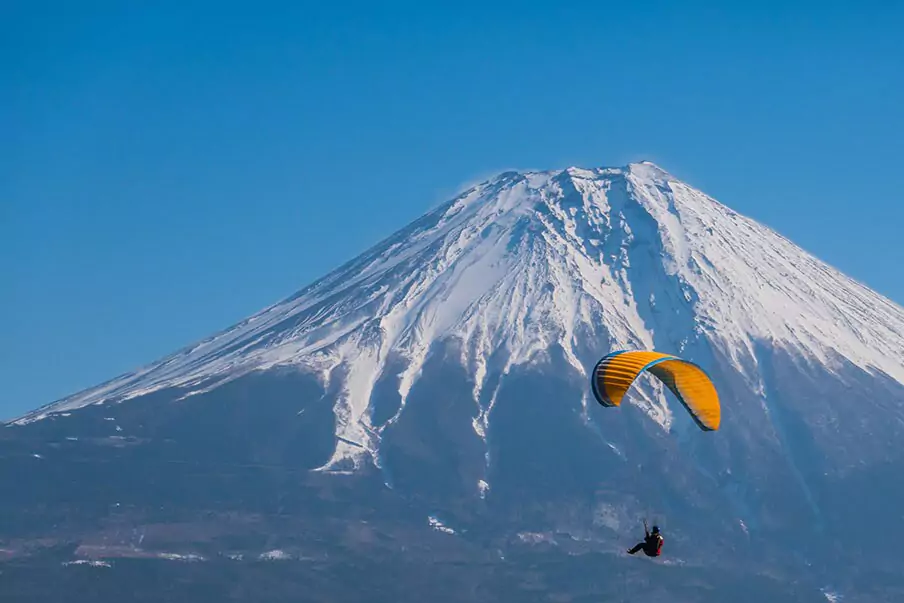Mount Fuji, with its majestic snow-capped peak, has captivated the hearts and imaginations of people worldwide for centuries. Standing tall at 3,776 meters (12,388 feet), it’s not just Japan’s highest mountain but a symbol of the country’s natural beauty and cultural heritage. Ultimately, embarking on a Mount Fuji expedition is a challenging yet rewarding experience, offering breathtaking scenery, a sense of accomplishment, and a deep connection with Japanese culture.
Why Climb Mount Fuji?
Climbing Mount Fuji is a bucket-list adventure for many, and for good reason. Here are just a few reasons why you should consider this incredible journey:
- Stunning Scenery: Witness panoramic views of the surrounding landscapes, from lush forests and volcanic landscapes to the sprawling cityscape of Tokyo in the distance.
- Sense of Accomplishment: Furthermore, reaching the summit of Mount Fuji is a physical and mental challenge that will leave you with a profound sense of achievement.
- Cultural Significance: Moreover, Mount Fuji holds deep spiritual meaning in Japanese culture. Climbing it is often seen as a pilgrimage, with shrines and mountain huts along the way adding to the unique cultural experience.
- Sunrise Spectacle: Finally, witnessing the sunrise from the summit, known as “goraiko,” is an unforgettable experience and a highlight for many climbers.
Choosing Your Mount Fuji Expedition
There are several factors to consider when choosing your Mount Fuji expedition:
Climbing Routes
Mount Fuji has four main climbing routes, each with its own characteristics and difficulty level:
- Yoshida Trail: The most popular route, offering a gradual ascent and numerous mountain huts.
- Subashiri Trail: In contrast, this trail is known for its volcanic scenery and less crowded trails.
- Gotemba Trail: However, this is the longest and most challenging route, with a steeper incline and fewer huts.
- Fujinomiya Trail: Similarly, the shortest route, but also the steepest, with rocky terrain.
Guided vs. Independent Climbing
- Guided Tours: Ideal for first-time climbers or those seeking a more structured experience. Specifically, guided tours provide expert leadership, logistical support, and added safety.
- Independent Climbing: On the other hand, this offers more freedom and flexibility, but requires careful planning and preparation.
Fitness Level and Acclimatization
Climbing Mount Fuji requires a good level of physical fitness. Therefore, it’s essential to train beforehand and acclimatize to the altitude to avoid altitude sickness.
Climbing Season
The official climbing season is from early July to mid-September when the mountain huts are open and weather conditions are 1 generally favorable.
Preparing for Your Mount Fuji Expedition
Proper preparation is crucial for a safe and enjoyable climb. Here’s a checklist of essential items:
- Sturdy Hiking Boots: Invest in comfortable, waterproof hiking boots with good ankle support.
- Layered Clothing: Additionally, be prepared for changing weather conditions with layers of clothing, including a waterproof jacket and pants.
- Headlamp: Essentially, this is essential for navigating the trails in the dark during early morning ascents.
- Hiking Poles: Indeed, these are helpful for stability and reducing strain on your knees, especially during descent.
- Backpack: A comfortable backpack to carry your essentials, including water, snacks, and extra layers.
- Water and Snacks: Above all, stay hydrated and energized with plenty of water and high-energy snacks.
- Sunscreen and Hat: Protect yourself from the sun’s intense rays at high altitude.
- First-Aid Kit: Naturally, carry a basic first-aid kit for minor injuries.
- Cash: Mountain huts may not accept credit cards, so bring enough cash for accommodation and refreshments.
Climbing Mount Fuji: What to Expect
Mountain Huts
Mountain huts provide basic accommodation and meals along the climbing routes. Consequently, they offer a place to rest, refuel, and escape the elements. Reservations are highly recommended, especially during peak season.
Altitude Sickness
Altitude sickness can affect anyone, even experienced climbers. As a result, ascend gradually, stay hydrated, and listen to your body. If you experience symptoms like headache, nausea, or dizziness, descend to a lower altitude immediately.
Weather Conditions
Mount Fuji’s weather can be unpredictable, changing rapidly from sunshine to rain or even snow. In this regard, be prepared for all conditions and check the forecast before you climb.
Crowds
Mount Fuji is a popular destination, and the trails can get crowded, especially during weekends and holidays. Instead, consider climbing on weekdays or during the shoulder seasons for a less crowded experience.
Reaching the Summit: A Rewarding Experience
Reaching the summit of Mount Fuji is an exhilarating moment. The panoramic views, the sense of accomplishment, and the shared experience with fellow climbers create a truly unforgettable memory. Subsequently, take your time to soak in the scenery, capture some photos, and savor the moment before beginning your descent.
Beyond the Climb: Exploring the Fuji Five Lakes Region
The area surrounding Mount Fuji, known as the Fuji Five Lakes region, offers a wealth of attractions and activities. Here are a few highlights:
- Lake Kawaguchiko: The most accessible of the five lakes, with stunning views of Mount Fuji and opportunities for boating, fishing, and hiking.
- Address: Fujikawaguchiko, Yamanashi Prefecture, Japan
- Estimated Opening Hours: Lake Kawaguchiko is open year-round, 24 hours a day. However, access to certain activities and attractions may vary depending on the season and operating hours.
- Contact Information: Fujikawaguchiko Tourist Information Center: +81 555-72-3111
- Lake Yamanakako:Likewise, this lake is known for its clear waters and recreational activities like swimming, windsurfing, and camping.
- Address: Yamanakako, Yamanashi Prefecture, Japan
- Estimated Opening Hours: Lake Yamanakako is open year-round, 24 hours a day. However, access to certain activities and attractions may vary depending on the season and operating hours.
- Contact Information: Yamanakako Tourist Information Center: +81 555-28-2822
- Lake Saiko:In addition, this is a quieter lake with opportunities for hiking, fishing, and exploring the Aokigahara Forest.
- Address: Fujikawaguchiko, Yamanashi Prefecture, Japan
- Estimated Opening Hours: Lake Saiko is open year-round, 24 hours a day. However, access to certain activities and attractions may vary depending on the season and operating hours.
- Contact Information: Fujikawaguchiko Tourist Information Center: +81 555-72-3111
- Chureito Pagoda: A five-story pagoda offering iconic views of Mount Fuji framed by cherry blossoms in spring.
- Address: 2-chōme-4-1 Asama, Fujiyoshida, Yamanashi 403-0011, Japan
- Estimated Opening Hours: 9:00 AM to 5:00 PM
- Contact Information: +81 555-22-1111
- Fuji-Q Highland:Finally, this is an amusement park with thrilling roller coasters and attractions, including the Fujiyama, one of the world’s tallest roller coasters.
- Address: 5-6-1 Shinnishihara, Fujiyoshida, Yamanashi 403-0017, Japan
- Estimated Opening Hours: 9:00 AM to 5:00 PM (hours may vary depending on the season and day of the week)
- Contact Information: +81 555-23-2111
Practical Travel Tips for Your Mount Fuji Adventure
- Transportation: Access Mount Fuji by train or bus from Tokyo. The Fuji Five Lakes region is well-connected by public transportation.
- Currency Exchange: Beforehand, exchange your currency for Japanese Yen before arriving in the Fuji Five Lakes region.
- Cultural Etiquette: Familiarize yourself with basic Japanese customs and etiquette, such as bowing as a greeting and removing your shoes before entering temples and homes.
- Language: While English is spoken in some tourist areas, learning a few basic Japanese phrases can enhance your experience and interactions with locals.
Transliteration: Essential Japanese Phrases for Your Mount Fuji Expedition
Greetings
- Hello: Konnichiwa (Kon-ni-chi-wa)
- Good morning: Ohayo gozaimasu (O-ha-yo go-za-i-masu)
- Good evening: Konbanwa (Kon-ban-wa)
- Thank you: Arigato gozaimasu (A-ri-ga-to go-za-i-masu)
- Excuse me: Sumimasen (Su-mi-ma-sen)
Directions
- Where is [Mount Fuji]: [Fuji-san] wa doko desu ka? (Fuji-san wa do-ko de-su ka?)
- To the summit: Itadaki e (I-ta-da-ki e)
- Which way is the [Yoshida Trail]: [Yoshida] Tozan-do wa dochira desu ka? (Yoshida To-zan-do wa do-chi-ra de-su ka?)
- How far is it?: Dore kurai tooi desu ka? (Do-re ku-rai to-oi de-su ka?)
Dining
- I would like to order: Chumon o onegai shimasu (Chu-mon o o-ne-gai shi-masu)
- Water, please: Ohiya o kudasai (O-hi-ya o ku-da-sai)
- Delicious: Oishii desu (O-i-shii de-su)
- Check, please: Okaikei o kudasai (O-kai-kei o ku-da-sai)
Emergencies
- Help!: Tasukete! (Ta-su-ke-te!)
- I need a doctor: Isha o yonde kudasai (I-sha o yon-de ku-da-sai)
- I am lost: Michi ni mayotte shimaimashita (Mi-chi ni ma-yot-te shi-mai-ma-shi-ta)
Additional Tips:
- Remember to speak respectfully and use polite forms of address.
- Carry a phrasebook or translation app for assistance with more complex communication.
- Be patient and understanding if there are language barriers.
Real-Life Stories: Unforgettable Experiences on Mount Fuji
- “The sunrise from the summit was unlike anything I’ve ever seen. It was a truly spiritual experience.” – Sarah J., Australia
- “Climbing Mount Fuji was a challenge, but the sense of accomplishment was incredible. The views were breathtaking, and the camaraderie with fellow climbers was amazing.” – David K., United Kingdom
- “I’ve always dreamed of climbing Mount Fuji, and it exceeded my expectations. The mountain huts were cozy, the food was surprisingly good, and the whole experience was unforgettable.” – Yumi N., Japan
Embrace the Challenge: Your Mount Fuji Expedition Awaits
Climbing Mount Fuji is a journey of physical endurance, mental fortitude, and cultural immersion. In essence, it’s a chance to connect with nature, challenge yourself, and experience the beauty and spirituality of Japan’s iconic peak. With careful planning and preparation, your Mount Fuji expedition will be an adventure you’ll cherish for a lifetime.






